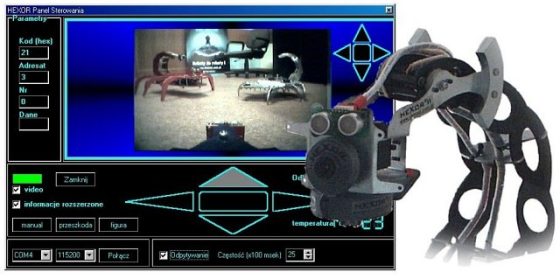Stenzel HeXoR II – a teaching aid for schools and research institutions
 The Stenzel Ltd. from Poland is a unique commercial-scientific venture in the Central Europe area. They are developing HeXoR, a mobile didactic robot which has been designed as a teaching aid for schools and research institutions. It can be lots of fun if you are an enthusiast, who is keen on robotics, informatics and electronics issues. The robot is modular hence it is possible to add new features like a compass, motion detector, light intensity sensor, different gas concentration sensors and noise level intensity sensors.
The Stenzel Ltd. from Poland is a unique commercial-scientific venture in the Central Europe area. They are developing HeXoR, a mobile didactic robot which has been designed as a teaching aid for schools and research institutions. It can be lots of fun if you are an enthusiast, who is keen on robotics, informatics and electronics issues. The robot is modular hence it is possible to add new features like a compass, motion detector, light intensity sensor, different gas concentration sensors and noise level intensity sensors.
HeXoR II is their current top model which is a unique combination of a six-legged platform, driven by means of DC servo-mechanisms, with a modern microprocessor controller and a set of sensors and data acquisition systems from the robot’s environment. It’s provided with the basic software which controls the robot. Basing on the supplied software in BASIC, the user may create his own programs in assembler or C language.
The control software gives the user access to already implemented functions like determination of the direction of movement, possibility of measuring the distance from the obstacle, possibility of measuring robot’s environment temperature and switching on or switching off additional peripheral equipment mounted on the robot.
The existing control software enables transmission of pictures from the camera situated on the robot’s body to the PC computer screen. It is possible to equip the robot with a cordless camera operating in the LAN local network, WAN or GSM. The robot can play the role of a mobile internet camera, controlled from the browser level. In case of transmitting pictures to a more powerful stationary computer the developers say that there will be a possibility of robot control based on processing images coming from the HeXoR II mounted camera.
It has been equipped with an infrared light, which enables it to see in conditions of complete darkness and it can be provided with a voice recognition system. The machine reaction may also be supplemented by the emission of voice announcements. Their range depends on the range of applied processor.
The robot is controlled from a computer by a radio link. The reach of the link ranges from more than a dozen meters in a building to several dozen or even several hundred meters in open space. You can create your own operating if you are able to make applications in Visual Basic or Delphi, or by using the programming tools added to the robot. Therefore, robot’s operation can be controlled in many ways – the machine’s possibilities are limited only by your imagination.
A unique teaching program, designed for technical secondary schools with electric, computer science or mechatronics profile of studies is based on HeXoR II development. Thanks to its use the students will be able to observe the effects of their previous theoretical study. Beside the new didactic program for the subject of robotics, there is a great possibility of using the robot as a teaching aid within the framework of existing teaching subjects such as: physics, electronics, digital technology, microprocessor technology and mechatronics. HeXoR makes an excellent platform for boosting creativity of students, rousing their inventiveness and enabling quick realization of their ideas. This machine will allow students to compete by organizing robot contests or battles. The use of totally safe and generally available laser indicators gives the possibility of a battle between two HeXoR robots. Programming the robot in such a way so that it finds an exit out of a labyrinth as quickly as possible, is also a challenge for future engineers from the IT branch. Group games such a ball or robot fights are becoming an increasingly more popular entertainment. In spite of obvious analogies to real sports, it is in fact a refined challenge between the developers of these devices.
Besides many uses as a teaching aid the HeXoR robot has other development possibilities. In future it can be transformed into a professional service robot. Machines of this type can be used by disabled persons. Another potential area of using mobile robots is to support guards watching over people or property.










Leave your response!